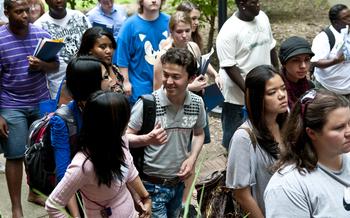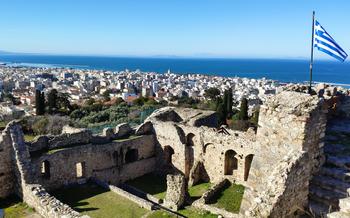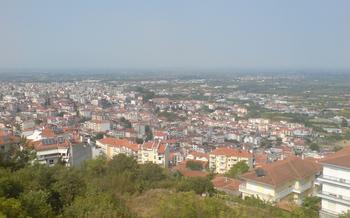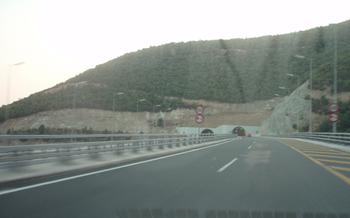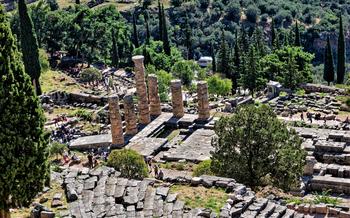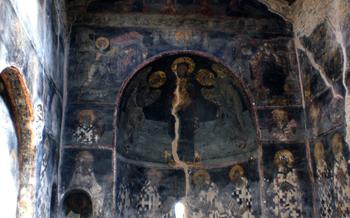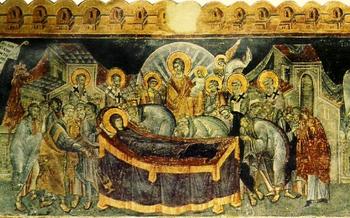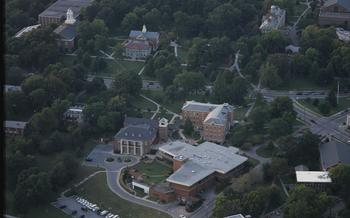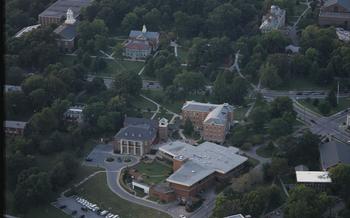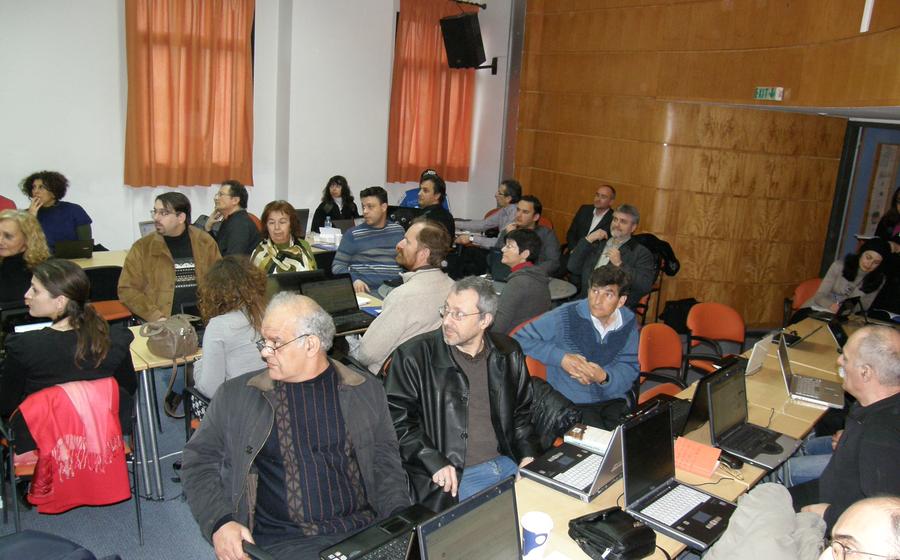
The Monastery of Panagia Eleousa
- History of the Monastery of Panagia Eleousa
- Visiting the Monastery of Panagia Eleousa
- Exploring the Monastery Grounds
- Attending Religious Services
- Meeting the Monks
- Learning about the Monastery's Art and Culture
- Participating in Monastery Activities
- Staying Overnight at the Monastery
- A Walk in Nature around the Monastery
- Local Cuisine and Dining Options
- Shopping for Souvenirs and Local Products
- Exploring the Village of Veria
- Day Trips from the Monastery
- Photography and Social Media
History of the Monastery of Panagia Eleousa
Nestled in the picturesque town of Veria, the Monastery of Panagia Eleousa stands as a testament to Greece's rich religious heritage. Its story begins in the 11th century when a group of devout monks, seeking refuge from worldly distractions, established a small monastery on this serene hilltop. Over the centuries, the monastery grew in size and significance, attracting pilgrims and visitors from far and wide.
In the 14th century, a devastating fire ravaged the monastery, destroying much of its original structure. However, the monks, undeterred by this setback, rebuilt the monastery with even greater splendor and devotion. The architectural style of the rebuilt monastery reflects a harmonious blend of Byzantine and Ottoman influences, showcasing the region's unique cultural heritage.
Throughout its history, the Monastery of Panagia Eleousa has played a pivotal role in the spiritual and cultural life of Veria. It served as a center of learning and religious education, with monks transcribing and preserving ancient manuscripts. The monastery's impressive collection of icons and frescoes, created by skilled Byzantine artists, further enhanced its reputation as a sanctuary of art and spirituality.
Today, the Monastery of Panagia Eleousa continues to be a beacon of faith and a source of inspiration for visitors from all walks of life. As you step through its ancient gates, you will be transported back in time, experiencing the profound spiritual essence that has resonated within these sacred walls for centuries.
Visiting the Monastery of Panagia Eleousa
Location and Directions: The Monastery of Panagia Eleousa is conveniently located just a short distance from the center of Veria. Take a leisurely stroll through the picturesque town, following the signs that will guide you to the monastery's gates. Alternatively, if you prefer a more scenic route, you can opt for a scenic drive along the winding roads that lead to the monastery, offering breathtaking views of the surrounding countryside.
Visiting Hours and Admission Fees: To ensure a respectful and enriching visit, the monastery welcomes visitors during specific hours. Please note that the monastery observes a strict dress code, requiring visitors to dress modestly and appropriately for a religious environment. Admission to the monastery is free of charge, allowing everyone to experience the spiritual and historical significance of this sacred place.
Accessibility: The Monastery of Panagia Eleousa strives to be accessible to all visitors, including those with disabilities. Wheelchair ramps and accessible pathways have been thoughtfully designed to ensure that everyone can navigate the monastery grounds with ease. If you have any specific accessibility needs, the friendly staff will be more than happy to assist you.
Exploring the Monastery Grounds
The Monastery of Panagia Eleousa boasts several architectural wonders that showcase its rich history and spiritual significance. As you explore the monastery grounds, be sure to marvel at the following:
-
The Main Church: The heart of the monastery is its main church, a stunning example of Byzantine architecture. Adorned with intricate frescoes depicting biblical scenes and the lives of saints, the church's interior is a testament to the artistic prowess of the monastery's founders. Don't miss the impressive dome, which features a beautiful mosaic of Christ Pantocrator.
-
The Refectory: Step into the refectory, where the monks once gathered for their meals. Admire the well-preserved mosaics that adorn the walls, depicting scenes from the New Testament and the lives of the early Christians. These mosaics provide a glimpse into the daily lives of the monks and the spiritual teachings that guided their community.
-
The Bell Tower: Ascend the bell tower for breathtaking panoramic views of the surrounding countryside. From this vantage point, you can admire the lush forests, rolling hills, and distant mountains that envelop the monastery. The sound of the bells, echoing through the valley, adds a sense of tranquility and serenity to the atmosphere.
-
The Surrounding Gardens and Courtyards: Take a stroll through the monastery's beautiful gardens and courtyards, where you can find respite from the hustle and bustle of everyday life. Enjoy the vibrant colors of the flowers, the gentle murmur of the fountains, and the soothing shade of the trees. These serene spaces invite you to pause, reflect, and connect with the spiritual essence of the monastery.
Attending Religious Services
The Monastery of Panagia Eleousa welcomes visitors to attend religious services and experience the spiritual traditions of the Orthodox faith. The daily schedule of services includes morning prayers, the Divine Liturgy, and evening prayers. Visitors are encouraged to participate in these services, which offer a profound insight into the monastic way of life.
The Divine Liturgy is the central service of the day, during which the Eucharist is celebrated. Visitors are welcome to join the monks in prayer, singing, and receiving Holy Communion. The service is conducted in Greek, but visitors can follow along with the English translations provided.
Attending religious services at the monastery is a unique opportunity to witness the deep devotion and spirituality of the monks. Visitors are encouraged to approach the services with reverence and respect, observing the customs and traditions of the Orthodox Church. This includes dressing appropriately, refraining from talking during the service, and following the guidance of the monks.
Meeting the Monks
The monks at the Monastery of Panagia Eleousa live a life of dedication and devotion. Their daily routine revolves around prayer, work, and community. Visitors to the monastery have the opportunity to meet and interact with these monks, gaining insights into their unique way of life.
The monks are typically happy to greet visitors and share their experiences. They may give tours of the monastery, lead discussions on religious topics, or simply engage in conversation. Visitors may also have the opportunity to observe the monks at work, whether it be in the fields, the kitchen, or the workshops.
It is important to remember that the monks are busy with their duties and should not be disturbed unnecessarily. Visitors should be respectful of their privacy and refrain from asking intrusive questions. However, if visitors are genuinely interested in learning more about the monks and their lives, they will likely be welcomed with open arms.
Learning about the Monastery's Art and Culture
The Monastery of Panagia Eleousa is home to a significant collection of Byzantine art, including icons, frescoes, and mosaics. The main church is adorned with stunning frescoes depicting scenes from the Bible and the lives of the saints. The refectory, or dining hall, features well-preserved mosaics depicting various religious and historical subjects. The monastery's collection of icons is also impressive, with many dating back to the 12th and 13th centuries.
Visitors to the monastery can learn about the history of its art collection and the significance of the individual works through guided tours or by reading informative plaques and displays. The monastery also organizes workshops and events related to art and culture, providing visitors with an opportunity to learn more about Byzantine art and its techniques.
The monastery's art collection is not only a testament to the skill and devotion of its creators but also a valuable resource for scholars and historians studying Byzantine art and culture. The monastery's role in preserving this important heritage is vital, ensuring that future generations can appreciate and learn from these remarkable works of art.
Participating in Monastery Activities
The Monastery of Panagia Eleousa offers various opportunities for visitors to participate in monastery activities and immerse themselves in the daily life of the monks. Visitors can join the monks in their prayers, attend workshops and lectures, or volunteer their time to help with tasks around the monastery.
One way to participate is by joining the monks in their daily prayers. Visitors can attend the morning and evening services, which are held in the main church of the monastery. These services are a beautiful and moving experience, and visitors are welcome to participate as much or as little as they like.
The monastery also offers workshops and lectures on a variety of topics related to monastic life and Byzantine art. These workshops and lectures are a great way to learn more about the history and culture of the monastery, and they are open to visitors of all ages.
For those who are interested in getting more involved, there are opportunities to volunteer at the monastery. Volunteers can help with tasks such as gardening, cleaning, and cooking. Volunteering is a great way to give back to the monastery and to learn more about monastic life.
Participating in monastery activities is a unique and rewarding experience. It is a chance to learn about the history and culture of the monastery, to connect with the monks, and to experience the peace and tranquility of monastic life.
Staying Overnight at the Monastery
For those seeking a truly immersive experience, the Monastery of Panagia Eleousa offers the opportunity to stay overnight within its hallowed walls. Guest rooms, designed with simplicity and functionality in mind, provide a tranquil haven for visitors. Staying overnight at the monastery is not merely about lodging; it is an invitation to delve deeper into the monastic way of life. Guests are welcome to join the monks for their daily prayers and services, partake in communal meals, and engage in meaningful conversations about spirituality, history, and culture.
The experience of staying overnight in a monastery is unique and transformative. It offers a glimpse into the daily rhythms and rituals of monastic life, fostering a sense of peace, introspection, and connection to a higher power. It is an opportunity to disconnect from the distractions of modern life, reconnect with oneself, and explore the depths of one's spiritual journey.
Guidelines and expectations for overnight guests are provided to ensure a harmonious and respectful stay. Visitors are encouraged to embrace the monastery's serene atmosphere, maintain silence in designated areas, and dress modestly. Reservations are essential and can be made in advance through the monastery's official website or by contacting the guestmaster directly.
Whether seeking spiritual enrichment, a unique cultural experience, or simply a tranquil retreat, staying overnight at the Monastery of Panagia Eleousa promises to be a memorable and deeply rewarding experience.
A Walk in Nature around the Monastery
The Monastery of Panagia Eleousa is nestled amidst a breathtaking natural landscape that invites visitors to explore the wonders of the surrounding environment. A network of well-maintained hiking trails winds through the picturesque countryside, offering a variety of scenic walks for nature enthusiasts of all levels.
As you embark on your walk, you will be greeted by a diverse array of flora and fauna. The air is filled with the sweet fragrance of wildflowers, and the vibrant colors of butterflies and birds create a lively tapestry against the backdrop of lush greenery. Keep an eye out for shy creatures such as rabbits and squirrels, which often dart across the path, adding a touch of magic to your journey.
One of the highlights of the walk is the opportunity to witness the monastery's impressive vineyards, which stretch across the rolling hillsides. These vineyards, meticulously tended by the monks, produce grapes that are used to create the monastery's own wine, a local delicacy that is highly prized for its rich flavor and aroma.
As you continue your walk, you will encounter several vantage points that offer panoramic views of the surrounding countryside. Take a moment to soak in the beauty of the landscape, with its patchwork of fields, forests, and distant mountains. The tranquility of the setting is sure to soothe your mind and leave you feeling refreshed and revitalized.
Whether you are an experienced hiker or simply seeking a leisurely stroll, the natural surroundings of the Monastery of Panagia Eleousa provide an idyllic backdrop for a memorable and rejuvenating experience.
Local Cuisine and Dining Options
The Monastery of Panagia Eleousa offers visitors a unique opportunity to sample traditional Greek cuisine prepared with fresh, local ingredients. The monastery's dining facilities serve a variety of dishes, including hearty stews, grilled meats, and fresh salads, all made with produce grown in the monastery's own gardens.
One of the highlights of the monastery's cuisine is the use of traditional recipes that have been passed down through generations of monks. These recipes often incorporate local herbs and spices, giving the dishes a distinctive and flavorful taste. Visitors can also enjoy freshly baked bread and pastries, made daily by the monastery's bakers.
The monastery's dining facilities are open to both visitors and pilgrims, and meals are served family-style, encouraging a sense of community and togetherness. Visitors can choose to dine in the refectory, a historic dining hall with vaulted ceilings and stone walls, or in the outdoor courtyard, which offers stunning views of the surrounding countryside.
Dining at the Monastery of Panagia Eleousa is not just a culinary experience but also a cultural one. It is an opportunity to immerse oneself in the traditions and way of life of the Greek Orthodox Church, while enjoying delicious, home-cooked meals made with love and care.
Shopping for Souvenirs and Local Products
The Monastery of Panagia Eleousa has a gift shop where visitors can purchase a variety of souvenirs and local products. These include handmade crafts, religious items, and traditional Greek delicacies. The gift shop is run by the monks themselves, and all proceeds go towards supporting the monastery and its ongoing operations.
When shopping at the monastery's gift shop, be sure to look for unique and meaningful souvenirs. The monks often create their own handicrafts, such as pottery, wood carvings, and jewelry. These items are not only beautiful but also serve as a reminder of your visit to the monastery.
In addition to handicrafts, the gift shop also sells a variety of local products, such as honey, olive oil, and wine. These products are made by local farmers and artisans, and they offer a taste of the region's rich culinary traditions.
By shopping at the monastery's gift shop, you are not only supporting the monastery but also the local economy. The monks and local artisans rely on the income from the gift shop to sustain their livelihoods. So, when you purchase a souvenir from the monastery, you are not only taking home a piece of Greece but also helping to preserve the local culture and traditions.
Exploring the Village of Veria
The village of Veria, where the Monastery of Panagia Eleousa is located, is a treasure trove of history, culture, and natural beauty. Take a break from the tranquility of the monastery and venture into the village to discover its many charms.
Ancient Origins and Rich History
Veria boasts a rich history dating back to ancient times. In the 4th century BC, it was a significant city in the kingdom of Macedon, the birthplace of Alexander the Great. Explore the ancient ruins scattered throughout the village, including the Roman baths, the agora, and the city walls, which offer a glimpse into Veria's glorious past.
Cultural Heritage and Local Traditions
Veria's cultural heritage is deeply rooted in its traditions and customs. The village is home to several museums, including the Archaeological Museum of Veria, which houses a collection of artifacts from the region's rich history. Don't miss the Folklore Museum, which showcases traditional costumes, household items, and tools, providing a glimpse into the daily life of Veria's people.
Local Festivals and Events
Veria comes alive during its many festivals and events. The most famous is the Anastenaria, a fire-walking ritual held every January to celebrate Saint Anastasios. This unique tradition, deeply rooted in ancient beliefs, is a spectacle not to be missed. Other festivals include the Feast of Saint George in April, featuring traditional music and dancing, and the Wine Festival in September, where you can sample local wines and delicacies.
Gastronomic Delights
Veria's cuisine is a delight for foodies. Indulge in traditional dishes such as tourlou, a vegetable stew, or papoutsakia, stuffed eggplant with minced meat. Don't forget to try the local cheese, feta, and the sweet treat, kataifi, a filo pastry filled with nuts and honey.
Tips for Exploring Veria
- Allow yourself at least half a day to explore Veria's highlights.
- Wear comfortable shoes as the village is best explored on foot.
- Visit the tourist information center for maps, brochures, and recommendations.
- Take advantage of the village's many tavernas and cafes to sample local cuisine.
- Respect local customs and traditions, especially during religious festivals.
Day Trips from the Monastery
The Monastery of Panagia Eleousa is strategically located within easy reach of several charming towns and villages, each with its unique character and attractions. Embark on a day trip to discover the rich history, stunning landscapes, and local traditions of the surrounding region.
Veria: Just a short drive from the monastery, Veria is a vibrant town steeped in history and culture. Explore the 14th-century Byzantine walls, marvel at the stunning frescoes of the Panagia tou Vlaherna church, and stroll through the charming cobbled streets lined with traditional shops and tavernas.
Naousa: Venture further afield to Naousa, a picturesque town nestled among the rolling hills of Imathia. Wander through the narrow streets adorned with colorful mansions, visit the Folklore Museum to learn about local traditions, and indulge in the town's renowned cuisine, including the famous "fasolada" (bean soup).
Edessa: Known as the "City of Waters," Edessa boasts a stunning array of waterfalls, lush parks, and historical landmarks. Explore the ancient ruins of the Edessa Acropolis, admire the cascading waters of the Edessa Waterfalls, and take a refreshing dip in the thermal springs.
When planning your day trips, remember to consider transportation options. Renting a car provides the flexibility to explore at your own pace, while organized tours offer a convenient and hassle-free way to visit multiple destinations.
Whether you choose to explore the historic streets of Veria, savor the local flavors of Naousa, or immerse yourself in the natural beauty of Edessa, the surroundings of the Monastery of Panagia Eleousa offer a wealth of experiences to enrich your journey.
Photography and Social Media
The Monastery of Panagia Eleousa offers a treasure trove of photo opportunities for visitors. From the intricate details of its architecture to the stunning vistas of the surrounding countryside, there is no shortage of picturesque scenes to capture. However, it is crucial to remember that the monastery is a place of worship and reverence, so visitors should be respectful when taking photos. Avoid using flash photography inside the church or refectory, and be mindful of any signs or requests from the monks regarding photography.
Sharing your experiences of the monastery on social media can be a wonderful way to spread the word about this hidden gem and inspire others to visit. When posting photos or videos, be sure to tag the monastery's official accounts and use relevant hashtags to help your content reach a wider audience. Remember to always be respectful and mindful of the monastery's sacred nature, and avoid posting anything that could be considered inappropriate or offensive.
Here are some tips for capturing beautiful photos and creating engaging content at the Monastery of Panagia Eleousa:
-
Use natural light: The best time to take photos is during the early morning or late afternoon, when the light is softer and more flattering.
-
Experiment with different angles: Don't just stick to straightforward shots. Try shooting from different angles and perspectives to create more interesting and dynamic compositions.
-
Pay attention to the details: The monastery is full of intricate details, from the carvings on the walls to the patterns on the floor tiles. Take your time to explore and capture these details in your photos.
-
Include people in your shots: Adding people to your photos can help to create a sense of scale and bring the monastery to life. Just be sure to ask for permission before photographing anyone.
-
Be respectful: Remember that the monastery is a place of worship and reverence. Be respectful of the monks and other visitors, and avoid doing anything that could be disruptive or disrespectful.
